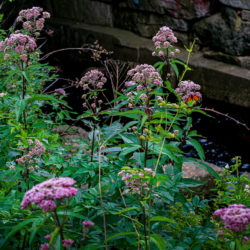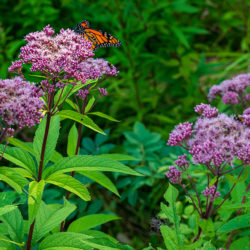Etymology
Eutrochium is Greek for truly wheel-like (due to the whorled leaves); maculatum is Latin and refers to spotted stems.
Native Habitat
Damp meadows, thickets and coastal areas in eastern North America.
Garden Uses
Late summer-blooming, tall attraction in moist gardens such as rain gardens, low areas and pond edges. May be susceptible to powdery mildew.
Overview
This ornamental pink to purple flowering, perennial herb grows stiffly erect up to 6 feet tall, with very fibrous roots and stems. It prefers sun to part-shade and moist soil, but can tolerate some dryness once established.
Leaves and Stems
Leaves are simple, serrated, and ovoid, and grow in whorls of 3 to 5 along the main stem. They are yellowish- green, up to 8 inches long, and 2-1/2 inches wide, with conspicuous veins. Main stems are stout, unbranching, toughly fibrous, purple or purple-spotted and typically covered with fine white hairs.
Flowers
Pink to purple flowers occur in late summer in large, flat-headed clusters, which contain 8-20 very small disk florets, with none of the outer irregular rays seen in many sunflower species.
Fruit/Seed
Individually-seeded dry pods, which do not split open (achene); each has hair-like bristles at the tip for dispersal by wind.
Animal Associates
Flowers are fragrant, and attract butterflies, and some moth larvae (caterpillars). Not a preferred food source for mammals, so is infrequently browsed.
Propagation
Collect seed heads in early autumn, place upside down in a paper bag, hang to dry. Direct seed in autumn or refrigerate until sowing in spring. Keep soil moist. Flowers second season. The fibrous crown of established plants can also be divided and replanted in the autumn. Can self-seed if left standing over winter.
Ethnobotanical Uses
The common name is thought to refer to a healer (legends vary as to whether this was a Native American or European colonist) who used this plant for a variety of tonics; however, it is now identified as a liver toxin and should not be imbibed.
Garden Location
Library Garden (see garden map)
Anecdotal Information
Genus changed in 2000 to differentiate this plant from Eupatorium which is similar but has opposite leaves, rather than whorled.
Sources
Clemson University Cooperative Extension
Lady Bird Johnson Wildflower Center
Plant Profile by Kate O’Dell


